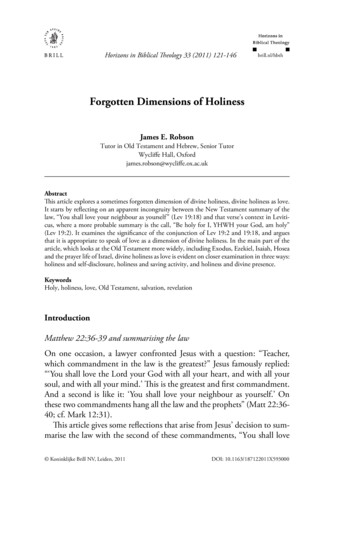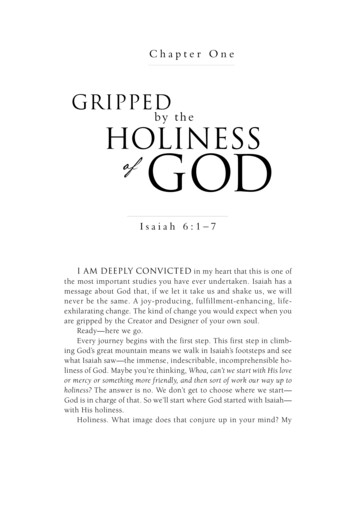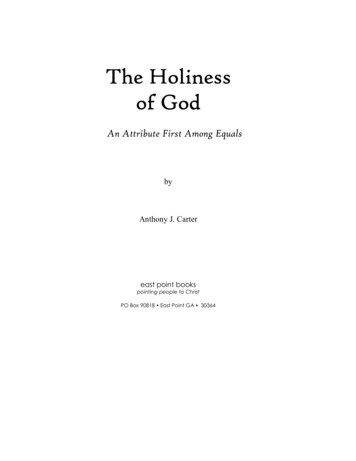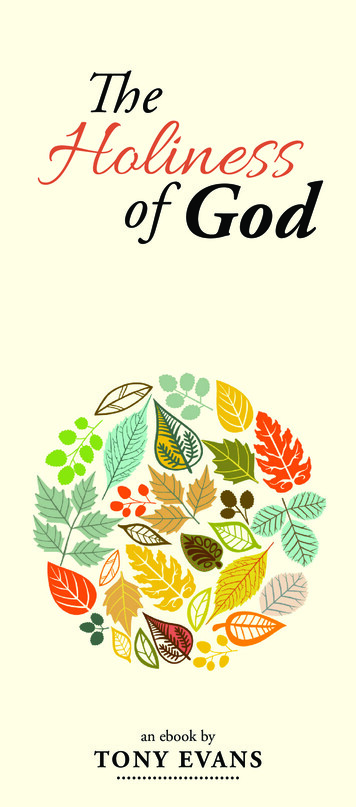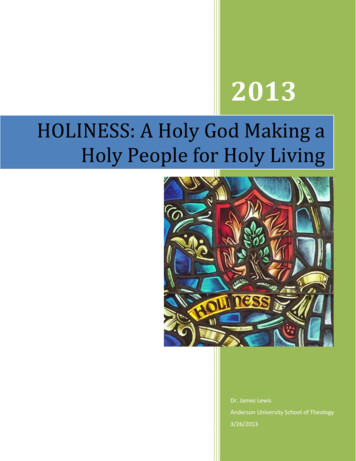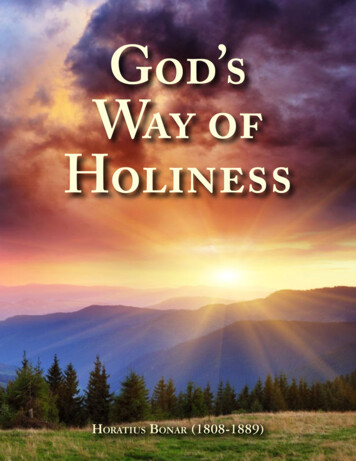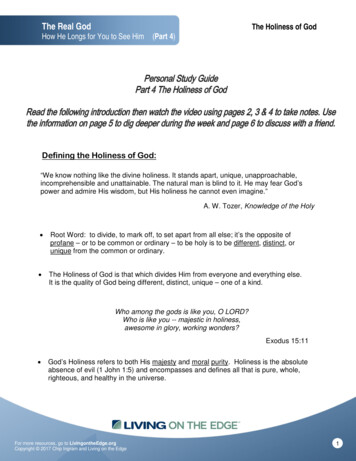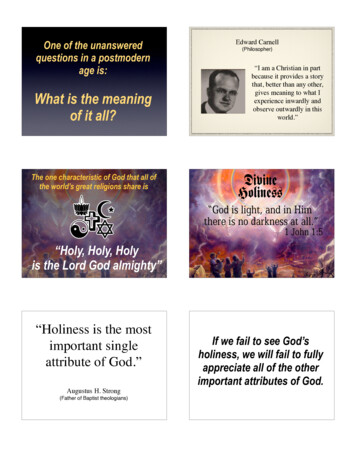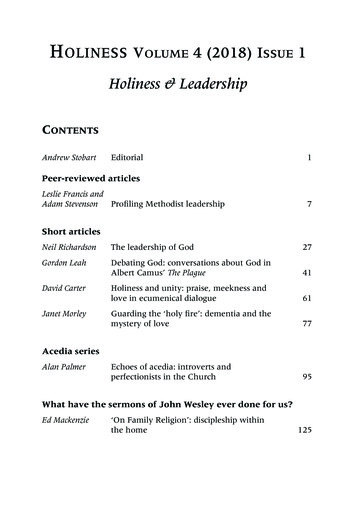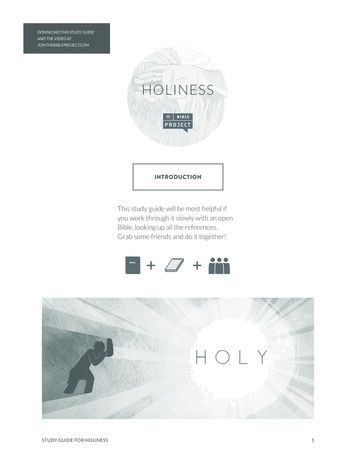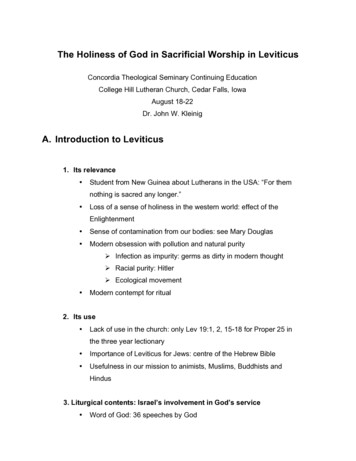
Transcription
The Holiness of God in Sacrificial Worship in LeviticusConcordia Theological Seminary Continuing EducationCollege Hill Lutheran Church, Cedar Falls, IowaAugust 18-22Dr. John W. KleinigA. Introduction to Leviticus1. Its relevance Student from New Guinea about Lutherans in the USA: “For themnothing is sacred any longer.” Loss of a sense of holiness in the western world: effect of theEnlightenment Sense of contamination from our bodies: see Mary Douglas Modern obsession with pollution and natural purityØ Infection as impurity: germs as dirty in modern thoughtØ Racial purity: HitlerØ Ecological movement Modern contempt for ritual2. Its use Lack of use in the church: only Lev 19:1, 2, 15-18 for Proper 25 inthe three year lectionary Importance of Leviticus for Jews: centre of the Hebrew Bible Usefulness in our mission to animists, Muslims, Buddhists andHindus3. Liturgical contents: Israel’s involvement in God’s service Word of God: 36 speeches by God
Ø Address to Moses as cult founder and mediator (32x)Ø Address to Moses and Aaron (11:1; 13:1; 14:33)Ø One address to Aaron (10:8-11)Ø Seventeen as teaching for the people (1:2; 4:1; 7:23, 25;11:1; 12:1; 15:2; 18:2; 20:1; 23:2, 10, 24, 34; 24:2; 25:2;27:2) and the whole assembly (19:2)Ø Five as teaching for the priests (6:9, 25; 21:1; 22:2, 17)Ø Two as teaching for the priests and the people (17:2; 22:18)Ø One as teaching for Aaron (21:19) God’s institution of the divine service by his wordØ Divine mandate: legislation as God’s gift of the divine serviceto IsraelØ Divine authorisation and empowerment Purpose of divine institutionØ Liturgical “enactment” of God’s word: see the use of theformula of compliance with God’s word in 8:4, 36; 16:34;21:24; 23:44; 24:23 and the formula of execution of God’sword in 8:9, 13,17, 21, 29; 9:7, 10, 21.Ø Cooperation with God in enacting his wordØ Sanctification of the service by his word in 20:7-8:Consecrate yourselves and be holy, for I am the Lord yourGod. Keep my statutes and do (enact) them; I am the Lordwho sanctifies you (pl).Ø Avoidance of the occult practices of pagan rituals Terms for God’s wordØ Ritual “statute” (huqqah) on what is to be done (eg. 3:17)Ø Ritual “ordinance” (mishpat) on how the service is to be done(eg. 5:10; 9:16)Ø Ritual “teaching” (torah) on right enactment (eg. 6:9, 14, 25)Ø Ritual “commandment/mandate” (mitzvah) that authorises aright enactment in the divine service (eg. 22:31; 26:3, 14, 15;
27:34) or prohibits a wrong enactment (eg. 4:2, 13, 22, 27).See the summary in 27:34 about the whole bookØ Ritual “provision” (hoq) of food from the offerings for thepriests (eg. 6:17, 18, 22; 7:34) Shift in location for God’s speaking in 1:1Ø from Mt Sinai in ExodusØ to the tabernacle Narrative context: sacred procession of the Israelites with God fromEgypt to CanaanØ Part of ongoing story: historical originv Events at Mt Sinai: Exodus 19 to Numbers 10v After the building of the tabernacleØ Continuation of narrative in three placesv Ordination of priests and inauguration of the divineservice in 8-9 followed by the death of Aaron’s sonsfor desecration in 10v Institution of the Day of Atonement in response to thedeath of Aaron’s sons in 16v Stoning of a man for blaspheming the holy name in24:10-23B. Theological Framework of Leviticus1. The theology of holiness as the key to Leviticus:See God’s word to Moses in 19:2: Speak to all the congregation of the peopleof Israel and say to them, “You will be holy, for I the LORD your God amholy.” Self-declaration and self-presentation as intrinsically holy: I the Lordyour God am holy.
See also 11:44-45; 20:7, 26 as well as the remarks about the priests in21:6-8, and the claim that the priests are “holiness/a holy thing/ a holyplace” in 21:6Ø Holiness as a liturgical termØ No definition of holiness as it has to do with God’s divine being Call to be holy in 19:2Ø Promise: You will be holyØ Demand: You shall be holyØ Statement of fact: You are holy Ongoing source of holiness: I am the Lord, who sanctifiesØ Holy people: 20:8; also 21:8; 22:32Ø Holy things: 21:23; also 22:16Ø Holy priests: 22:9; also 21:15 Sanctification by God’s name and his word in 22:31-33:I am the Lord; you therefore shall keep my commandments by enactingthem. I am the Lord; you shall therefore not desecrate my holy name, sothat I may show myself as holy among the Israelites. I am the Lord, whomakes you holy, who brought you out of the land of Egypt to be yourGod. I am the Lord.Ø My holy name: the name of my holiness, the name of mysanctuary, my sanctuary name (cf. 20:3; 22:2)Ø Connection of the name with the sanctuary (20:3) and theofferings (22:2)Ø LXX for 22:2: the name of my sanctified thingsØ Desecration of the Lord’s name by its ritual misuse (19:12; 20:3;21:6) Sanctification by divinely instituted rites in 20:7-8: You shall sanctifyyourselves and you shall be holy, for I am the Lord your God. You shallkeep my statutes and enact them; I am the Lord, who makes you holy. God’s consecrating presence in the divine service in Ex 29:43: There (atthe altar) I will meet with the children of Israel, so that it (Israel or altar)
may be consecrated by my glory.Ø Liturgical participation in God’s holinessØ Reception of it through holy meals Reception of God’s holiness by contact with the most holythingsØ Altar of burnt offering: Ex 29:37Ø Anointing oil: Ex 30:29Ø Meat from sin and guilt offerings: Lev 6:17-18, 27Ø Bread from grain offerings: Lev 6:17-18 The use of the formula for sanctification by physical touch:whoever/whatever touches x will become holy.Ø The altar for burnt offering (Ex 29:37) as well as the ark, the tablefor the bread, the lampstand, the altar for incense and the laver(Ex 30:26-29)Ø The bread from the grain offerings of the priests and the meatfrom the sin and guilt offerings (6:14-18, 27 Distinction in 21:22Ø Most holy things that sanctify (means of grace)Ø Holy things/offerings that are sanctified by them (5:15, 16; 12:4;19:8; 21:22; 22:2, 3, 4, 6, 7, 10, 12, 14,15, 16) Degrees of holiness from proximity to GodØ Holy of Holies: Holy Place: courtyard: campØ High priest: priests: Levites: lay Israelites God’s wrath at the desecration of his holinessØ Death from desecration by the performance of strange/alien/unauthorised service: case of Nadab and Abihu in10:1-3Ø Death from the individual desecration by defilement:15:31Ø Exile from corporate desecration: 20:22-26 Result of sanctification: safe access to God’s blessings
2. God’s mandate to Aaron and the priests in 10: 10-11:Then the Lord said to Aaron, ‘You and your sons are to distinguishbetween the holy and the common, and between the unclean andthe clean; and you are to teach the people of Israel all the statutesthat the Lord has spoken to them through Moses.’ The holy: what is divine and in God’s presence (thetabernacle, the meat of a sacrificed animal) The common: what is permitted for human use in the order of creation(sex, ordinary food) The unclean: forbidden as disorderly, unnatural and perverted in theorder of creation (sickness, homosexuality) The clean: the proper, natural condition of something common (bread,sexual intercourse in marriage)3. Impurity as the opposite of holiness Powers rather than concepts Impurity as the opposite of God's holiness Impurity as a life-denying and destructive power Incompatibility with God’s holinessØ Darkness by lightØ Petrol by fire Problem of impurity: 15:31: Thus you shall separate theIsraelites from their impurity, so that they do not die in theirimpurity when they defile my tabernacle that is in their midst.Ø Death from defilement of God’s holiness: wrath rather thangraceØ Separation for safe access to God’s holy presence: avoidanceof desecration and death (7:20-21)Ø Exclusion of unclean people from participation in the divineservice (12:5)
Defilement by contact with impurity Spiritual power of impurity from desecration of holiness No creature as intrinsically clean or unclean Impurity as an unnatural power: association with disorder anddeath Demons as the source of impurity (?) unclean spirits in NT4. Three domains from God’s holy presence on earth The clean holy domainØ Order of salvation: rule by the gospelØ Luther: kingdom of God’s right hand The clean common domainØ Order of creation: rule by the lawØ Luther: kingdom of God’s hand The unclean common domainØ Domain of darkness: disorder and chaosØ Dominion of pagan gods and the occultGod's Presence nPurificationCommonanduncleanDefilement
Evil Powers5. Four changes: states of being before God Desecration: transference of something holy into acommon state (redemption of firstborn son) Defilement: transference of something clean into anunclean state (touching a corpse) Purification: transference of something unclean into aclean state (washing after menstruation) Sanctification: the transference of something clean intoa holy state (presentation of offering to God)6. Three kinds of ritual impurity Physical disorder (sickness, irregular menstruation) Moral disorder (adultery, murder) Religious disorder: occult use (menstrual blood, semen, corpses, pork)7. Degrees of impurity Mild formsØ Sexual emission: until eveningØ Menstruation: seven days Worst forms: excommunication or death in 20Ø Sacrifice of children to Molech for prosperityØ Consulting mediums and spiritistsØ Cursing parentsØ Sexual abuses: adultery, incest, sodomy, bestiality Difference of focus in 18 and 20Ø God’s life-giving ordinances and statutes for all humanity: 18:2-5
Ø God’s penalties for the desecration of his holiness by his holypeople in the Promised Land: 20:22-26 Self-pollution and the pollution of the holy land by four kinds of impurityØ Sexual impurityØ Child sacrifice to Molech idolatryØ MurderØ Spiritism (20:27; cf. 19:26, 31 Requirement: greater purity for those who are closer to God8. Purity as a liturgical rather than social or moral category in Leviticus Origin in God rather in certain classes of people as is common in mostcultures Impurity of all Israelites including the priestsØ Connection with sin: unclean environmentØ Cleansing of minor impurities by washingØ Cleansing of serious impurities: blood Need for continual purification Rules for purity and impurityØ Admission to God’s presence: safe accessØ Inclusion in the holy congregationØ Maintenance of holy status Unclean food as forbidden for liturgical use Use of the Ten Commandments for lay diagnosis of impurity anddesecration9. Use of theology of purity and holiness Connection of physical life with the divine serviceØ Tabernacle homeØ Holy meals common mealsØ God’s work human workØ God’s blessing procreation
Demand for purity from the Lord’s holy presence with His people in Hisland Sanctuary as bridgehead for holiness: home, land and world Call to “do guard duty”Ø People for clean land: 18:30Ø Priests for holy sanctuary: 8:35; 22:9 Importance of the body and its locationC. Structure of Leviticus1. Legislation for offerings and removal of impurity: 1-15a. The manual of offerings for the divine service Voluntary God-pleasing offerings (1:1-3:17)Ø Burnt offeringsØ Grain offeringsØ Peace offerings Mandatory offerings for atonement (4:1-6:7)Ø Sin offeringsØ Guilt offerings Consumption of holy food (6:8-7:38)Ø The public burnt offeringØ Most holy bread from the daily grain offeringØ Most holy meat from the sin offeringØ Most holy meat from the guilt offeringØ Holy meat from the peace offeringb. The inauguration of the divine service Consecration of the priests (8) Inaugural performance of the divine service (9) Penalty and remedy or desecration (10)c. The manual for purity Clean and unclean meat (11)
Impurity from childbirth (12) Impurity from skin diseases and fungus in a house (13-14) Impurity from genital discharges (15)2. Purification on Day of Atonement: 163. Participation in God's holiness: 17-27a. The use and abuse of blood from animals (17)b. Avoidance of sexual impurity: life-preserving ordinances for humanity(18)c. The holiness code: participation in God's holiness (19-26) Holiness of the congregation (19-20) Holiness of the priests (21-22) Holy times for worship: liturgical calendar (23) Holy things: lamp stand, show bread, the Lord’s name (24) Holy land: sabbatical and jubilee years (25) Results of right or wrong worshipØ Blessings from respect for holy things (26:113)Ø Penalties for desecration (26:14-39)Ø Restoration after repentance (26:40-46)d. An appendix on the treatment of votive offerings and tithes (27)D. Theology of Worship1. The Daily Sacrifice Its location at the tabernacle
The arrangement of the tabernacle in three zonesØ The Holy of Holies as God's private quarters: throne made up ofthe mercy seat, the cherubim as the throne-bearers and the arkas the footstoolØ The Holy Place as God's audience room for priests with the altarfor incense, the lampstand and the table for the showbread.Ø The courtyard with the altar for burnt offering as the place forpublic assembly and meeting The terms for the tabernacleØ The LORD’searthly dwelling place for him to dwell with Hispeople(mishkan: 8:10;15:31; 26:11)Ø The LORD’s sanctuary (miqdash 12:4; 16:33; 20:3; 26:2)Ø The Tent of Meeting (‘ohel mo’ed) where the LORD met withMoses to speak with him (1:1) The function of the daily service as the public offeringØ Public service for all IsraelØ Combination of three offerings: basic food stuff for Israelitehouseholdv Burnt offering: male lamb
v Grain offering: flour, olive oil and incensev Drink offering: wineØ Times: morning and eveningØ Order of enactmentv Splashing of blood on altar: atonementv Burning of incense in the Holy Place: intercessionv Burning of lamb and oil soaked flour with its incense:meetingv Aaronic benediction: blessingØ Meal: eating holy food by the priests on dutyØ Framework for other offeringsv Additional offerings for festive occasionsv Family offerings on the three pilgrim festivals : peaceofferings and grain offeringsv Offerings for pastoral needs: sin and guilt offerings The inauguration of the divine service in chapter 9Ø Purpose of the service in 9:6: This is what the Lord hascommanded you to do, so that the glory of the Lord may appearto you.v Climax of the story of God’s gloryv Egypt (Ex 13:20-22)v Red Sea (Ex 14:19-25)v Desert (Ex 16:6-10)v Top of Mt Sinai (Ex 19:16-19 and 24:15-18)v Face of Moses (Ex 34:29-35)v Tabernacle (Ex 40: 34-38)v Daily serviceØ Manifestation as fire on the altar: 9:24v Origin: the Holy Of Holiesv Source of the perpetual fire on the altar (6:8-13)v Use for the burning of incense in the Holy Place
v Use for the production of sweet smelling smoke aspleasing aroma for and from the LORDv Technical term hiqtir: sending up in smoke (9:10, 13, 14,17, 20)v Association with the perpetual fire on the altar and thepillar of smoke from the daily burnt offeringØ Connection with the benediction and jubilation: 9:23Ø Daily theophany in the divine service: see the common idiom ofappearing before the Lord God’s acceptance of his people in the divine serviceØ Function of the incense and the burnt offering:cloud of fragrant smokeØ Formula of approval: a pleasing aroma to the LordØ Formula of acceptance: for your acceptance (1:3; 19:5;22:19, 20) God’s meeting with the congregation in Exodus 29:42-45:For generations to come this burnt offering is to be made regularlyat the entrance to the Tent of Meeting before the Lord where I willmeet you (priests) and speak to you (Aaron); there also I will meetwith the children of Israel so that it may be sanctified by my glory; Iwill sanctify the Tent of Meeting and the altar and sanctify Aaronand his sons to serve me as priests. I will dwell among the childrenof Israel, and I will be their God.Ø God’s meeting with the priests and the Israelites at the altarrather than in the Holy of HoliesØ God’s sanctification of the priests and the Israelites by Hispresence through the most holy thingsØ God’s dwelling among them in the tabernacle as hisdwelling place to act as their God2. The Personal Offerings of the Israelite Families The personal offerings as an addition to the national offerings
Ø Presentation by the families at the three pilgrimfestivalsØ Peace offering with offering of bread and wineØ Provision of food for holy meal as God’s guests(Deut 12:17-18; 14:22-23)Ø Presentation after the public burnt offering in the middle ofthe dayØ Placement on the lamb for daily burnt offering The offering of grain offering with olive oil and frankincense: 2:1-16Ø Offering of first ripe grain (2:14) and the first processedproduce (2:12) as rent for the landØ Grain as flour or bread without yeastØ Smoking up of the memorial portion with incenseØ Leftover flour or bread from cereal offering for priests asmost holy food for themØ Consecration of other bread as holy foodØ Provision of holy bread from the Lord’s table from tithes:27:30-33 Peace offerings of domesticated animals: 3:1-17 and 7:28-34Ø Rare consumption of meat in ordinary life except on specialoccasionsØ Offering of firstlings: first born male animals from flock andherd (Deut 15:19-20)v Sheep, goats, cattlev Animal without defectØ Three kinds of peace offeringsv Thank offerings: offerings with song of thanksgivingv Votive offerings: offerings to fulfil a promisev Free will offeringsØ Slaughter by head of the householdØ Disposal of blood by the priest
Ø Presentation of breast with fat and right thighv Right thigh: officiating priestv Breast: shared among the priests on dutyØ Burning of fat with kidneys and liver lobeØ Eating of holy meat as Lord’s guestsv Family with guests: Levites and poorv Families of priests: food from God’s tableØ Theological purpose in 19:5: God’s approval andacceptance of person with offering3. Impurity and the Need for Atonement The need for atonement: 10:1-3Ø Problem: how can unclean people meet with their holy Godwithout desecrating his holiness?v Impurity desecrationv Desecration wrathv Wrath death: see the proverbial cases of Nadaband Abihu in 10:1-3 and of the sons of Korah in Num16-17Ø Treatment of impurityv Avoidance of contact with unclean thingsv Washing for minor impuritiesv Atonement for major impuritiesv Cleansing from impurity: forgiveness Basic sense of kipphpher: to perform the rite of atonementby which the Lord cleanses people and things from impurityØ Propitiation: God’s grace rather than His wrathagainst impurityØ Expiation: cleansing and release from sin The use of blood for atonement in 17:11: The life of the flesh is inthe blood, and I myself have given it to you to make atonement for
your lives upon the altar, because it is the blood that makesatonement by means of the life.Ø Drinking of blood in pagan rites for the lifepower ofanimalsØ Reservation of blood for atonementØ Institution of rite of atonementØ Application of blood on the altarØ Ransom of person’s life by the blood of the animalØ Cleansing and forgiveness through the bloodØ Prevention of desecration by defilement Regular rite of atonement: splashing of blood against thesides of the altarØ Burnt offeringØ Peace offering Rite of atonement with a corporate sin offering forpurification of the high priest and congregationØ Two young bullsØ Disposal of bloodv Sprinkling 7x against the curtainv Smearing of horns of incense altarv Pouring on base of altarØ Disposal of meatv Fat burnt on altarv Incineration of all meat outside camp Rite of atonement with sin offering for the purification of a lay person(4:27-35)Ø Male goat for tribal leaderØ Female goat or lamb for lay personØ Disposal of bloodv Smearing on horns of the altarv Pouring at base of the altar
Ø Disposal of meatv Fat burnt on the altarv Eating of most holy meat by priest Atonement on the Annual Day of AtonementØ Fasting by peopleØ Sin offeringsv Male bull for priestsv Male goat for peoplev Male scapegoatØ Rite of atonement for the Holy of Holiesv Sprinkling of bull’s blood: once on the mercy seat andseven times on the floor (8x)v Sprinkling of goat’s blood: once on the mercy seatand seven times on the floor (8x)Ø Rite of atonement for the Holy Placev Bull’s blood: smeared on the four horns of theincense altar and sprinkled seven times on the floor(11x)v Goat’s blood: smeared on the four horns of theincense altar and sprinkled seven times on the floor(11x)Ø Rite for the altar of burnt offering in the courtyardv Mixing of most holy blood from bull and goatv Smeared on the four horns of the incense altar andsprinkled seven times on the altar (11x)Ø Bearing of iniquity by scapegoatv Levites for people: Num 18:23v Priests for Levites: Num 18:1v High priest for congregation: Ex 28:38v Scapegoat for sins of Israel: Lev 16:22Ø The theological purpose of the ritual enactment
v Atonement for all the sins of the Isarelites (16:34)v Cleansing the altar for burnt offering (16:19) and theIsraelites from impurity (16:30)v Reconsecration of altar for burnt offering for the newyear:16:19E. Living with a Holy God1. Reception of blessings through right worship: 26 Basic requirements: 26:1-3Ø Negative: avoidance of idolatryØ Positive: respect for holy day and holy place Four kinds of blessing: 26:4-12Ø Regular rainfall with good harvestsØ Peace with security and victoryØ Growth of families with abundant foodØ God’s residence and service of them Result: freedom to walk as his royal people: 26:13 Repentance and restoration: 26:40-452. Living as holy people in God’s holy presence: 19:1-18 Call to share God’s holiness: 19:1-2 Common participation in God’s holiness: 19:3-10Ø Respect for parents as holy peopleØ Observance of SabbathØ Avoidance of idols: worst desecrationØ Respect for holy offerings Rule of justice and love in God’s holy community: 19:1118 Avoidance of defilement
Ethics of holinessv Israel as holy communityv Priestly fraternityv Communal participation in God’s holinessv Common holiness justice and solidarity in loveFurther ReadingNote that all my articles can be accessed www.johnkleinig.com Douglas, Mary. Purity and Danger. Routledge & Kegan Paul: London , 1966. Haran, Menahem. Temples and Temple Service. Winona Lake, Indiana:Eisenbrauns, 1985. Kleinig, John W. “Witting or Unwitting Ritualists,” Lutheran TheologicalJournal 22 (1988): 13-22. Kleinig, John W. “Sharing in God’s Holiness,” Lutheran Theological Review 8(1995/1996): 105-18. Kleinig, John W. “The Blood for Sprinkling: Atoning Blood in Leviticus andHebrews,” Lutheran Theological Journal 33 (1999): 124-35. Kleinig, John W. “The Lord’s Supper as a Sacrificial Banquet,” Logia 12(2003): 11-16. Kleinig, John W. Leviticus. Concordia Commentary. St Louis: ConcordiaPublishing House, 2003. Kleinig, John W. The Glory and the Service. Worship in the Old Testament.Transcribed lectures by Steven P. Mueller, Lawrence R. Rast, and Jesse E.Krusemark. Concordia Theological Press: Fort Wayne, 2004. Kleinig, John W. “Worship and the Way of Holiness,” Logia 16/1 (2007: 5-8. Kleinig, John W. “Luther on the Reception in God's Holiness,” Pro Ecclesia17/1 (2008): 76-91. Milgrom, Jacob. Leviticus 1-16. Doubleday: New York, 1991. Milgrom, Jacob. Leviticus 17-22. Doubleday: New York, 2000.
Milgrom, Jacob. Leviticus 23-27. Doubleday: New York, 2001.
The Holiness of God in Sacrificial Worship in Leviticus Concordia Theological Seminary Continuing Education College Hill Lutheran Church, Cedar Falls, Iowa August 18-22 Dr. John W. Kleinig A. Introduction to Leviticus 1. Its relevance Stud

